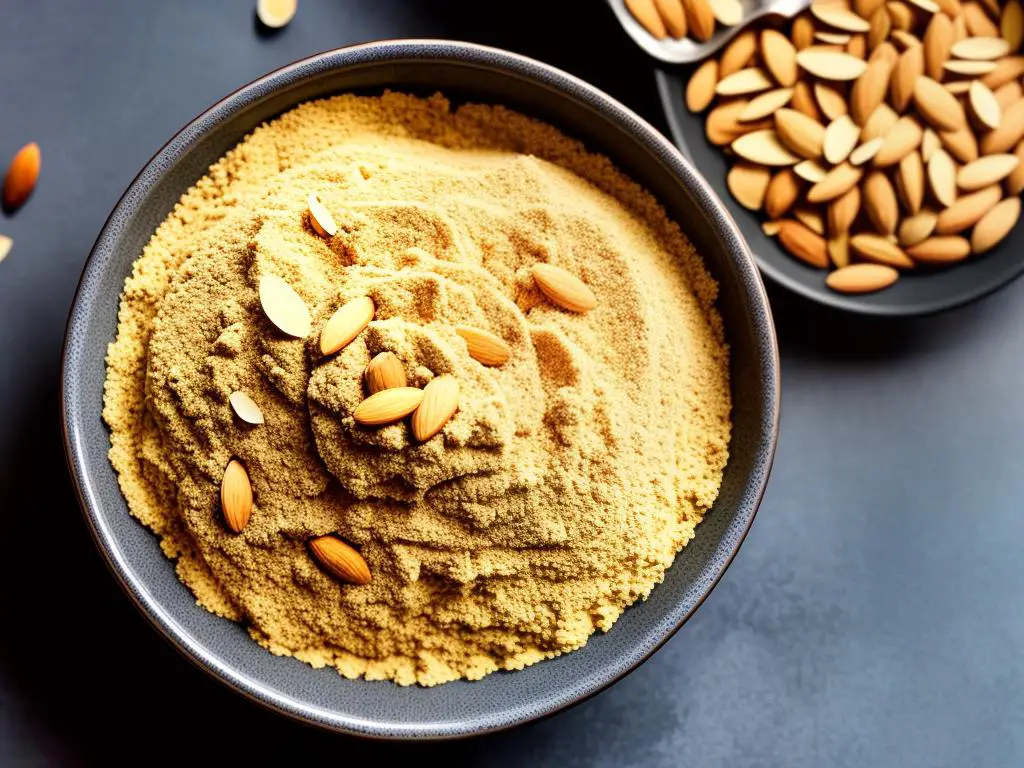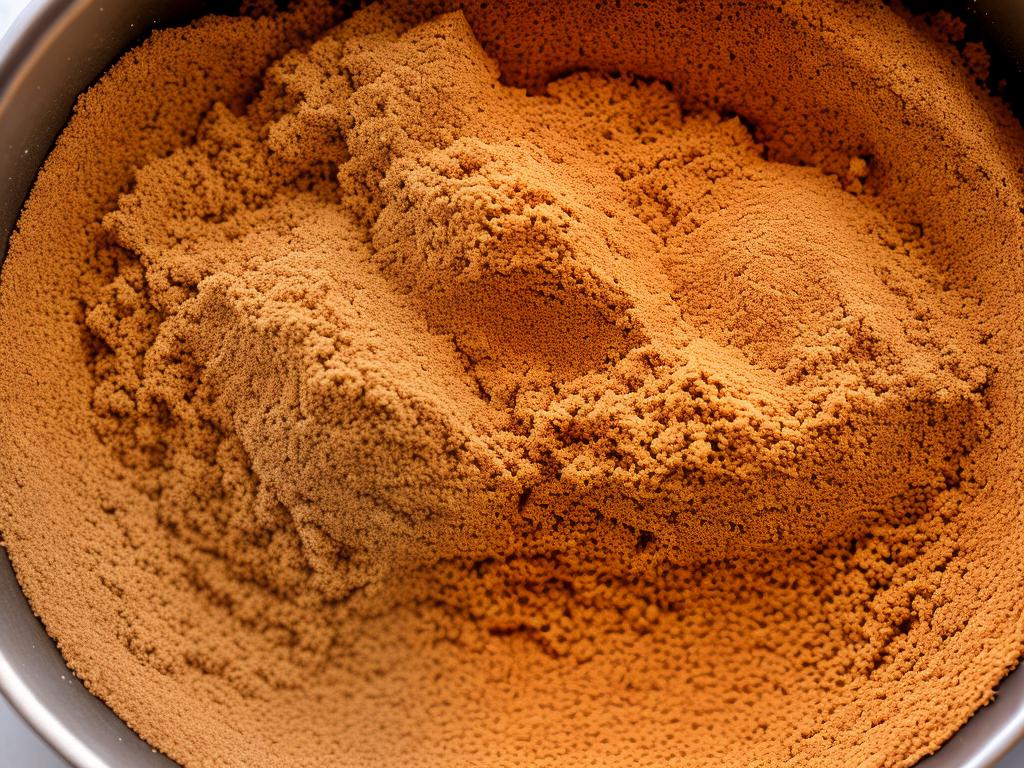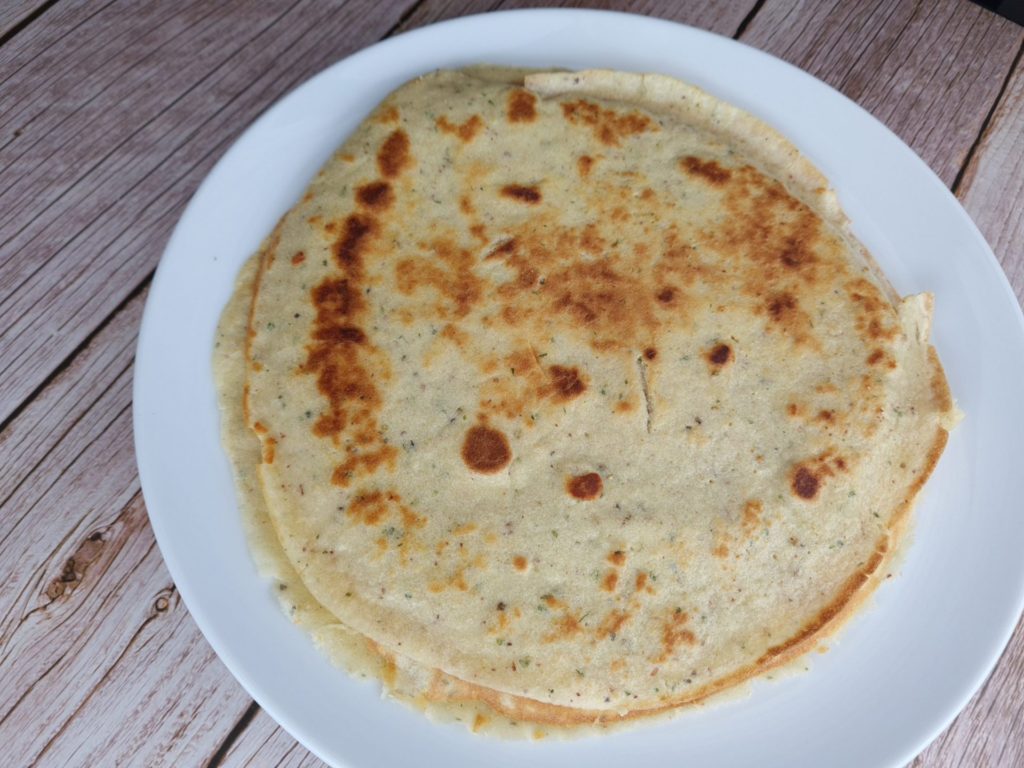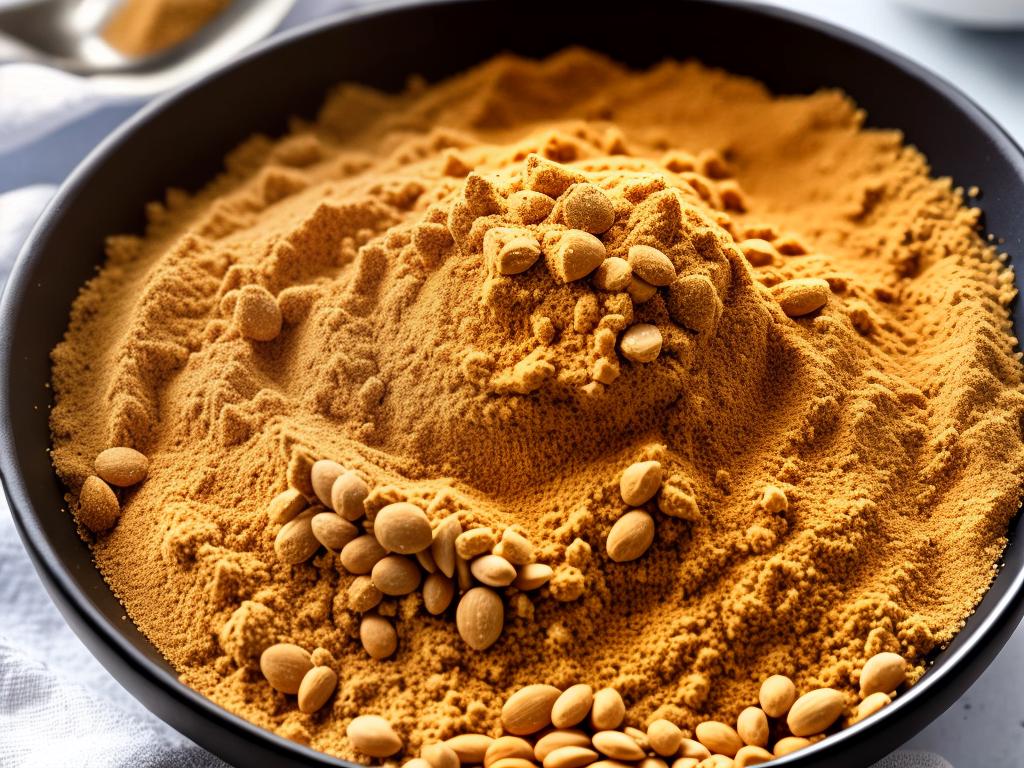Many of us seek healthier lifestyles, and selecting the right diet plays an integral part in this pursuit. A popular choice especially for those aiming for weight loss is the ketogenic, or keto, diet. One of the fundamental principles is to limit the intake of carbs. That has led to a surge in the usage of alternatives to regular wheat flour. One of the prominent substitutes is almond flour. This article explains almond flour, its nutritional content, how it becomes a great addition to a keto diet and some practical applications of using it in everyday recipes. It also discusses potential health concerns you may need to be aware of while using almond flour and provides useful tips on how to buy and store it effectively.
Table of Contents
What is Almond Flour
Understanding Almond Flour
Almond flour is a type of flour made entirely from almonds. The creation process often involves grinding blanched almonds into a fine powder. However, some versions of almond flour may include almond skins. They are typically referred to as almond meal. Whether blanched or all-inclusive, the ground almonds result in a flour-like consistency that can be used in many of the same recipes that require wheat flour.
Despite its similar usability, almond flour greatly differs in its nutritional profile compared to traditional wheat flour. It notably boasts a much lower carbohydrate content – a characteristic that makes it a popular choice among those adhering to the ketogenic (keto) diet.
A Nutritional Baking Substitute
Almond flour emerges as an ideal alternative to wheat flour due to its nutritional content that is aligned with ketogenic dietary guidelines. A diet that’s rooted in the drastic reduction of carbohydrate consumption. The keto diet focuses on high-fat and moderate-protein foods to stimulate the body’s use of fat as fuel instead of carbs.
With just a small portion of the carbs found in wheat flour, almond flour fits well into a low-carb, high-fat keto diet. Moreover, it packs in more protein, fiber, and healthy fats, making it a nutrition-dense option.
When substituted for wheat flour in baking, almond flour can offer a moist and tender texture to things like bread, muffins, and pancakes. It also has a nutty, slightly sweet flavor that can enhance a variety of baked goods.
New to keto diet? Learn more about keto diet and who to start your healthy weight loss journey here: Keto Diet Guide for Beginners: Complete Guide to Getting Started
Almond Flour Nutrition Facts
A quarter-cup serving of almond flour contains roughly 150 calories, 6 grams of protein, 11 grams of fat, 3 grams of fiber, and only 6 grams net carbs (total carbs minus fiber). It also provides a good source of essential nutrients, including Vitamin E, magnesium, and calcium.
Please be aware that different brands’ nutritional values may vary!
For everyone following a keto diet, the low net carb content takes precedence. This low level ensures that the body doesn’t revert to using carbohydrates and sugars for energy. Instead, continues to burn fat, thereby maintaining a state of ketosis. Thus, almond flour proves to be a promising choice for those pursuing a ketogenic lifestyle.
Using almond flour for baking is not just a practical choice for keto followers. It is also for those with dietary restrictions. Being naturally gluten-free, it’s safe for individuals with celiac disease or wheat intolerance. Its high protein and fiber content can additionally offer a longer feeling of fullness, which can benefit those targeting weight loss or blood sugar control.
However, it’s important to note that due to its higher fat content, almond flour is more calorie-dense than wheat flour. Portion control should be considered to prevent excessive calorie intake. It’s also more expensive than conventional flours and has a shorter shelf life. That is due to the natural oils present in the almonds that can turn rancid over time if not stored correctly.
Understanding the Role of Almond Flour in a Keto Diet
Almond flour is a splendid addition to any keto dieter’s pantry, thanks to its multi-purpose uses and low carbohydrate content. Apart from its primary use as a low-carb baking alternative, almond flour can be integrated into a plethora of keto-food recipes. You can use it to thicken broths and stews, as a substitute for breadcrumbs to coat meat or fish, and as the main ingredient in homemade keto-friendly bars and snacks. Such versatility underscores the value of almond flour within the ketogenic diet.
To sum up, almond flour does more than just replace regular flour in baking. It’s a nutrient-dense, low-carb, and highly adaptable ingredient that fits perfectly within the parameters of a ketogenic diet. Whether used in baking or cooking, almond flour contributes to nutritional enhancement while facilitating the maintenance of ketosis.
Benefits of Almond Flour in a Keto Diet
Why Almond Flour is a Must-Have for a Keto Diet
Those who adhere to the ketogenic, or keto, diet appreciate that its foundation rests on the consumption of high-fat, moderate-protein, and low-carbohydrate foods. While avocados, eggs, and meat are commonly recognized as staples of the diet, almond flour is a lesser-known yet equally valuable keto-friendly ingredient.
Almond flour, made simply by grinding almonds, boasts high levels of protein, healthy fats, and fiber. But perhaps the most appealing characteristic to keto dieters is its low carbohydrate content, with just 6 grams present in every quarter cup.
Get new recipes straight into your inbox!
We hate spam and promise to keep your email address safe.
Thank you!
You have successfully joined our subscriber list.
Nutrient-Rich Powerhouse
Almond flour isn’t just low in carbs, it’s also packed full of other nutrients that provide a variety of health benefits. The high protein and fiber content help keep you feeling satisfied, reducing food cravings—you might find you eat less overall, which can support weight loss. Further, almond flour contains vitamin E, magnesium, and monounsaturated fats, all of which contribute to heart health. The inclusion of vitamin E, a powerful antioxidant, can also help protect your cells from damage and slow the signs of aging.
Baking with Almond Flour
Almond flour is an excellent baking ingredient, which opens up a whole new world of low-carb breads, muffins, and other pastries for those adhering to a keto diet. Almond flour also helps make keto dessert options possible. Now, restricting carb intake doesn’t have to mean giving up baked goods entirely.
While the texture and taste differ slightly from traditional wheat flour, with a nuttier flavor and denser texture, most find it to be a delicious alternative.
Achieving Ketosis with Almond Flour
In the context of the keto diet, the low-carb nature of almond flour can help dieters achieve and maintain ketosis—a metabolic state in which your body burns fat for fuel instead of carbohydrates. By keeping your carbohydrate intake low, your body is forced to use fat as its main energy source. Almond flour, as a low-carb, high-protein, and high-fat food, is ideal for promoting ketosis.
The Role of Almond Flour in Weight Loss
Almond flour can play a significant role in weight loss within a ketogenic dietary plan. Because it boasts high quantities of healthy fats and proteins yet has a low carbohydrate content, almond flour can efficiently curb hunger and stimulate your metabolism. It’s essential to note that almond flour induces a lower insulin spike compared to standard flour, which can contribute to reduced cravings and prolonged energy levels—both of which are considerable benefits when on a weight loss journey.
With its combination of low carbs and a rich supply of other vital nutrients, almond flour is a perfect fit for a ketogenic diet. You can use it in a variety of ways, such as a thickener, a coating, or a key baking ingredient. Almond flour doesn’t just help you attain ketosis; it also aids in maintaining high energy levels and supports weight loss, thereby establishing it as a key element of a healthy, ketogenic lifestyle.
Practical Ways to Use Almond Flour in Keto Recipes
Getting Acquainted with Almond Flour on a Keto Diet
Almond flour has grown to be an extensively favored ingredient among those adhering to a ketogenic diet. It is derived from grinding sweet almonds into a finely textured powder, and it acts as a grain-free, low-carb substitute for regular wheat flour. Almond flour is an excellent choice for those following a Keto diet, as it aligns seamlessly with the specific macronutrient ratios required, notable for its richness in fats and proteins, yet scantiness in carbs.
Almond Flour in Keto Baking
When embarking on your Keto baking journey with almond flour, remember that this ingredient isn’t a one-for-one substitute for wheat flour due to the absence of gluten that provides structure in traditional baking. It will require a bit more egg or binding agent to help provide the structure and texture that baked goods generally have.
Almond Flour Keto Bread
Almond flour acts as the perfect base for a delicious, grain-free keto bread. It’s surprisingly easy to make and results in a loaf that’s soft and fluffy, yet sturdy enough for sandwiches. To bake, you’ll need almond flour, eggs, butter, baking powder, and a touch of salt. Leaven the dough with the baking powder and bake until golden.
Full recipe here:
Keto-Friendly Almond Flour Muffins
Muffins made with almond flour are another great breakfast option on a keto diet. Blueberry muffins made with almond flour have the same delightful taste and texture as traditional blueberry muffins. The main ingredients in this recipe are almond flour, blueberries, eggs, and sweetener of your choice, like a keto-friendly sweetener such as erythritol or stevia.
Recipe here: Muffins – Chocolate with Almond Flour
Get new recipes straight into your inbox!
We hate spam and promise to keep your email address safe.
Thank you!
You have successfully joined our subscriber list.
Almond Flour in Keto Meals
Shifting from baking, almond flour also works nicely in savory keto-friendly dishes.
Keto Almond Flour Pancakes
Fluffy pancakes don’t always have to be carb-loaded. With almond flour, it’s possible to make delicious, keto-approved pancakes for breakfast. The ingredients are similar to those used in baking bread, with the addition of a sweetening agent and vanilla extract.
Keto Almond Flour Pizza Crust
A family favorite, pizza, can be made keto-approved by using almond flour as the key ingredient in the base. Typically, you’ll need almond flour, mozzarella, cream cheese, and eggs for the crust, then top with your favorite low-carb pizza toppings.
Keto Pizza Recipes:
Possible Concerns and Side Effects
Decoding Almond Flour within the Keto Paradigm
In the realm of ketogenic, commonly known as “keto” diet, almond flour emerges as a favored ingredient; attributed to its low carbohydrate composition and high protein content. While it is packed with numerous health benefits, it is equally important to stay cognizant of any potential downsides or side effects it might bring.
Possible Allergic Reactions to Almond Flour
As with any food product, some individuals may have allergic reactions to almond flour. Symptoms of an almond allergy can range from mild itchiness and hives to more serious reactions like difficulty breathing. If you’re known to have a nut allergy, it’s advisable to steer clear of almond flour or consume it under the guidance of a medical professional.
If you have nut allergy, here is a list of keto friendly nut free flours:
The Best Keto Friendly Nut Free Flour Alternatives For Baking
High Calorie Content of Almond Flour
While almond flour is low in carbs, it’s high in fats and therefore calories. In a ketogenic diet, almond flour can play a beneficial role as dietary fats become the main source of energy. However, if you’re not careful about your intake, these high calories can lead to weight gain. It’s important to measure amounts and consume in moderation.
Overconsumption May Lead to Health Issues
While almond flour can be a great gluten-free and low-carb alternative, overconsumption might cause some health issues. Almonds are rich in polyunsaturated fats, which can increase inflammation when consumed in large amounts.
Moreover, almond flour is also a source of Phytic acid—a substance that can bind to minerals like iron, zinc, and calcium in your gut and prevent their absorption. Overconsumption can lead to a deficiency of some of these important nutrients over time.
Optimizing Almond Flour Use in Keto Diet
While integrating almond flour into your Keto diet provides numerous benefits, it’s crucial to keep in mind potential risks in order to make the most of this ingredient. For instance, individuals with known nut allergies should avoid using almond flour to prevent allergic reactions.
The high-calorie content of almond flour requires careful portion control. If it’s a staple in your meals and snacks, vigilantly track your consumption to ensure your daily caloric intake aligns with your goals—whether you’re looking to lose or maintain weight.
Considering the risk of overconsumption, diversify your flour usage. Rotate almond flour with other keto-friendly, low-carb flours like coconut flour or flaxseed meal. Keep in mind that while almond flour is a valuable addition to a keto diet, relying solely on it can be counterproductive. The ketogenic diet encourages a variety of nutrient-rich foods, so make sure to pair almond flour with a range of healthy proteins, fats, and vegetables to fulfill your body’s nutritional requirements.
The Best Keto Friendly Nut Free Flour Alternatives For Baking
Get new recipes straight into your inbox!
We hate spam and promise to keep your email address safe.
Thank you!
You have successfully joined our subscriber list.
Where to Buy and How to Store Almond Flour
Locating Almond Flour
Procuring almond flour is generally straightforward, as it’s readily available in most supermarkets, health food shops, and whole food stores across the widespread American landscape. For those who prioritize convenience, almond flour is easily purchasable online. Many prefer this method, patronizing grocery delivery services or ecommerce platforms like Amazon, which often stock larger quantities and offer bulk packages at competitive prices.
Choosing the Right Almond Flour
Not all almond flours are created equally. When purchasing, keep an eye out for “blanched almond flour” or “finely ground almond flour”. Blanched almond flour is made from almonds that have had their skins removed, leading to a smoother texture that resembles regular flour, ideal for baking.
Avoid almond meal as it differs significantly from almond flour. Almond meal is coarser and contains the skins of the almonds, leading to a denser texture. While it can still be used in baking, the results may vary as compared with those yielded by almond flour.
Also, consider choosing almond flour from brands that commit to non-GMO and gluten-free practices for healthier options.
Almond flour is more sensitive than regular flour due to its high oil content, so it’s important to store it properly to maintain its freshness. Keep an unopened packet of almond flour in a cool, dark, and dry pantry. Once it is opened, put it in an airtight container or sealed storage bag and refrigerate or freeze it to prevent the oils from becoming rancid. If you freeze it, let it come to room temperature before using it. Almond flour can stay fresh for up to a year when stored correctly. Check the flour before using it; if it has an off smell, it might be rancid and should not be used. Use almond flour in keto recipes to add nutritional value and a rich, nutty flavor to your dishes.
Understanding almond flour’s characteristics, nutritional value, and health benefits is an aid in effectively leveraging its potential in a keto diet. A versatile ingredient, almond flour blends seamlessly into numerous recipes offering a low-carb, high-fat content necessary for a keto lifestyle. However, it’s crucial to also bear in mind the potential downsides linked to overconsumption or allergies and select a balanced approach to its use. Being informed about where to purchase and how to store almond flour guarantees that its quality and shelf life are maintained, contributing positively to your cooking and health goals. Uncover the power of almond flour and let it boost your culinary adventures as you journey towards a healthier lifestyle.
Get new recipes straight into your inbox!
We hate spam and promise to keep your email address safe.
Thank you!
You have successfully joined our subscriber list.
- All
- Keto Cakes Recipes
- Keto Desserts Recipes
- Keto Ice Cream Recipes
- Keto Mug Cakes Recipes




























